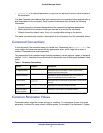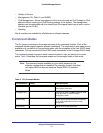
Using the Command-Line Interface
13
ProSafe Managed Switch
The port identifies the specific physical port or logical interface being managed on a given
slot.
Table 4. Type of Ports
Note: In the CLI, loopback and tunnel interfaces do not use the
unit/slot/port format. To specify a loopback interface, you use the
loopback ID. To specify a tunnel interface, you use the tunnel ID.
Using a Command’s “No” Form
The no keyword is a specific form of an existing command and does not represent a new or
distinct command. Almost every configuration command has a no form. In general, use the
no form to reverse the action of a command or reset a value back to the default. For
example, the no shutdown configuration command reverses the shutdown of an interface.
Use the command without the keyword no to re-enable a disabled feature or to enable a
feature that is disabled by default. Only the configuration commands are available in the no
form.
Managed Switch Modules
Managed switch software consists of flexible modules that can be applied in various
combinations to develop advanced Layer 2/3/4+ products. The commands and command
modes available on your switch depend on the installed modules. Additionally, for some
show commands, the output fields might change based on the modules included in the
software.
The software suite includes the following modules:
• Switching (Layer 2)
• Routing (Layer 3)
• IPv6—IPv6 routing
• Multicast
Port Type Description
Physical Ports The physical ports for each slot are numbered sequentially starting from zero.
Logical Interfaces Port-channel or Link Aggregation Group (LAG) interfaces are logical interfaces
that are only used for bridging functions.
VLAN routing interfaces are only used for routing functions.
Loopback interfaces are logical interfaces that are always up.
Tunnel interfaces are logical point-to-point links that carry encapsulated packets.
CPU ports CPU ports are handled by the driver as one or more physical entities located on
physical slots.





















